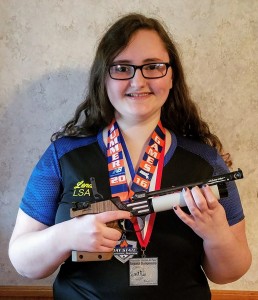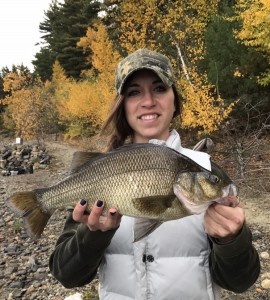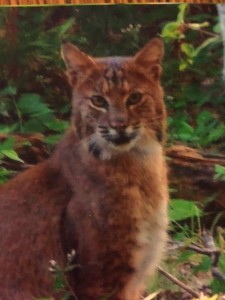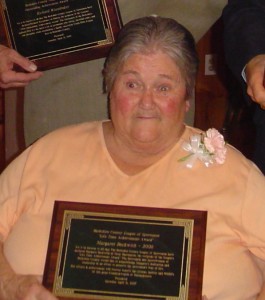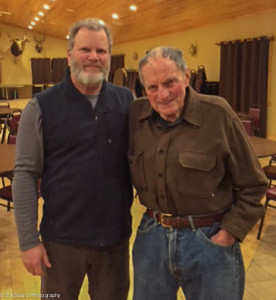Category Archives: Hunting
It’s a world record!
If this featured picture looks familiar, it is because I ran it in my October 30, 2016 column, and also mentioned it in a follow-up article of Val Percuoco and her sisters in my February 5, 2017 column. So why am I fixated on that fish?
Well, last week it was announced that not only was that 3 lb 8 oz white perch a state gold pin winner and the new state record, but it is also the new world record! That catch landed her in the Freshwater Fishing Hall of Fame in Hayward, Wisconsin. There, it was recently recognized as the Division 1 Rod and Reel 10 lb. Line Class World Record. About the same time, the International Game Fish Association (IGFA) recognized the fish as the new All-Tackle World Record for White Perch.
As you may recall it was caught out of Wachusett Reservoir north of Worcester. Check it out again, for its not every day that a world record fish is caught in Massachusetts waters.
Bald Eagles
According to MassWildlife, there are now more eagles nesting in Massachusetts than any time in the recent past, and they need your help keeping track of them. Please report eagle sightings to Andrew Vitz (MassWildlife’s State Ornithologist, andrew.vitz@state.ma.us). Many of our nesting eagles are banded with color-coded bands that identify the individual, so make sure to look for these leg bands whenever you see or photograph an eagle.
According to DFW Western District Supervisor, Andrew Madden, there will be a big push to locate nesting eagles in our area, especially in North County. They are particularly interested in evidence of nesting eagles (e.g., birds carrying sticks or sitting in nests). When there is evidence of a new breeding territory, DFW staff verifies the report as they monitor known nests. MassWildlife will conduct its Spring Eagle Survey on Friday, April 7. The Survey consists of coordinated teams of staff and volunteers who spread out across the state to check on historic nest sites and look for new nests.
According to MassWildlife, we have both Golden and Bald Eagles in the state. Both grow to approximately the same size, but the white head and tail of the adult Bald Eagle differentiates it from the Golden Eagle. Immature Bald Eagles may be confused with both immature and adult Golden Eagles.
The adult Golden Eagle is nearly uniformly dark without the mottling found on the immature Bald Eagle. Golden Eagles at any age may have relatively sharply defined, bright, clean white patches of varying size at the base of the inner primaries and outer secondaries on the wings and a clean white area at the base of the tail. All immature Bald Eagles have whitish axillaries and, depending on age, can have extensive, “dirty” white mottling virtually anywhere on the head, body, wing linings, and tail. The Golden Eagle’s legs are feathered to its toes; the legs of the Bald Eagle are unfeathered.
Basic Hunting Course
All first-time hunters who wish to purchase a Massachusetts hunting or sporting (combination) license must complete a Basic Hunter Education course. There will be such a course at the Becket Town Hall at 557 Main Street, Becket on April 10, 12 and 15. The times are: on April 10 from 5:30pm to 9:00pm; and on April 12 and 15 from 8:00am to 5:00pm. There may also still be openings in the scheduled class at the East Mountain Sportsmen’s Club which starts also on April 10 (previously mentioned in this column). To enroll call (508)389-7830.
Coyote Contest
Nineteen coyotes were entered into Dave’s Sporting Goods Coyote Contest this year, and the winners were as follows: Jay Fortier of Washington, MA bagged the most coyotes with a tally of 6. Joe Trybus, of Lanesborough, MA got the heaviest one which weighed 44 1/2 lbs. Congratulations to both hunters. Keep up the good work.
No trout stockings in the Western District yet
DFW WD Fisheries Manager Leanda Fontaine Gagnon went to check some access points during the week and because of the snowstorm, they have decided they were not able to start the stocking last week as planned. Probably they will start next week.
Club events
The Lee Sportsmen’s Association and Ducks Unlimited will be having its 3rd Annual Youth Sportsmen’s Gala dinner and raffle on Saturday, April 8 at the Country Club of Pittsfield. It is billed as a night of fantastic food, great raffle prizes, music and fun. Doors open at 4:00 pm and dinner served at 6:00 pm. The price is $100 per person. For more information, contact Virginia DuBois at (413)446-5404.
The Lenox Sportsmen’s Club is having its annual Spring Ham Shoots beginning today and running for the next three Sundays beginning at 12:30 pm. The costs are $3 per shot. You are encouraged to bring your shotguns and .22 cal rifle or pistol, as they have a few 22 shoots during the day as well. Prizes include hams, gift certificates and some other items. The kitchen will be open for burgers dogs, sausage and a few other items.
The Stockbridge Sportsmen’s Club will be having a 450 Round Indoor Archery Tournament to benefit the Aim for Higher Education Scholarship Fund on April 8 and 9. Click onto the club’s web site, events and calendar page to find out the times, prices, categories, etc. There will be a Chinese raffles and auction. There will be a spaghetti dinner at 6pm on Saturday and a pancake breakfast on Sunday Morning.
The Cheshire Rod & Gun Club will also have turkey and ham shoots every Sunday from March 26 until Easter. They start at 1pm and the cost is $3 a shot.
Most hunting seasons are closed
The rabbit and hare hunting seasons closed on February 28 and last Wednesday, the coyote and bobcat seasons also closed. And not a bit too soon for this attractive putty cat..
For some reason, we have been seeing an increase in bobcats lately, at least on the East side of Lenox. Jim Lahey of Lee was surprised last winter to see one stroll across his patio. A few years back, there was one that made its home in our neighborhood on East Street. That cat hung around for about three years. We were pretty sure it was the same one as it had a very distinctive limp. Neighbors Al and Martha Joyner got a kick out of watching it sunning itself on the top of their split rail fence.
The handsome bobcat pictured was photographed on the lawn of neighbor Tim and Kathy Face also of East Street a couple of months ago. According to Tim, she had two young kittens with her. I wish they would visit our place and put a dent into the vole population that has been creating havoc in our vegetable garden.
For many years there was a bounty on them, presumably put on by the DFW in response to farmers’ complaints. Like foxes, bobcats like to frequent the hen houses, too. The bounty system was ended in 1968.
If you see one of these beautiful animals, consider yourself lucky. There was a time when one would be lucky to see one or two in a lifetime.
Staying on the subject of wild cats (not wildcats) the bobcat’s larger cousin, the Canada lynx, has been sighted recently in Southern VT. One was photographed in Londonderry, VT, and biologists with the VT F&W confirmed the identification and visited the site to confirm its location.
Also, biologists suspect that a lynx was photographed by a game camera in nearby Searsburg, VT. It was photographed by a University of Vermont student who had set a trail camera out near a Rte 9 underpass. Chris Bernier, a wildlife biologist for the VT F&W was thrilled to see the animal using a wildlife underpass that was created for the express purpose of allowing animals to pass safely under the road.
These were the first confirmed evidences of lynx outside of Vermont’s Northeast Kingdom in decades. Lynx are listed as “threatened” under the Federal Endangered Species Act and “Endangered” in the state of Vermont. Are they headed our way?
Spring Trout Stocking About 500,000 brook, brown, rainbow and tiger trout will be stocked this spring from MassWildlife’s five hatcheries. These fish, coupled with the more than 80,000 fish stocked last fall, will provide some excellent fishing in the coming months. Stocking took place in the southeastern area of the state last week with other regions of the state expected to follow soon after. Anglers can get daily stocking updates at Mass.gov/Trout, or contact individual district offices for the latest stocking information.
The following are the 2017 spring trout stocking stats: Most of the trout will be over 12 inches, nearly half of them will be over 14 inches, more than 1,400 brown trout will be over 18 inches, more than 600 brook trout will be over 15 inches and more than 2,000 tiger trout will be over 14 inches.
Beware, ticks are bad this year
I had some free time and decided to take my beagle, Jacques, out rabbit hunting on February 27 before the season closed. I was hoping to bag a bunny and have it for a meal later in the week. It was so warm that day that I hurriedly switched out my regular hunting jacket for a lighter one and off we went.
After some time, Jacques kicked up a rabbit and he was hot on its scent. I picked an open spot where I could get a good shot, and while waiting for the bunny to circle back, I could practically taste that fried rabbit already. Feeling something crawling on my neck, I rubbed the area, but there was nothing there. A little while later I felt something crawling in my hair under my hat. This time I removed the hat, got out my comb and there was a tick. I looked down and there were five others crawling up my pants leg.
After killing them, I reached into my hunting jacket pouch to get the can of Permethren clothing repellent and plastic bag in which to carry the rabbit home. Oh oh, they were in my other hunting jacket. Well, I wasn’t going to carry that rabbit with ticks in my coat pouch without being sealed in a bag. No problem, I thought, I’ll simply field dress the rabbit and leave the fur and ticks in the woods. Guess what, my hunting knife was in the other jacket, too. It’s a wonder I remembered to bring my gun.
Jacques was barking excitedly and the rabbit was getting close. Now what? Do I shoot it and hand-carry it back home? No way, I could picture all of the ticks jumping off of it onto my hand and crawling up my arm.
The shotgun bead was right on the rabbit’s head, a chance for a nice clean shot, with no pellets in the meat. Nope, I didn’t shoot it and let the bunny hop away.
You have undoubtedly heard of lucky rabbit’s feet, well this was one lucky whole live rabbit.
Before leaving the woods, I pulled 3 more ticks off of my clothes. When we got home, we immediately washed up. Interestingly, he never had a tick on him.
Parting message: Use a good clothing repellent and check yourself often.
New England Turkey Hunting Hall of Fame inductees are announced
On January 28, Bass Pro Shops in Hooksett, New Hampshire, hosted the first New England Turkey Hunting Hall of Fame inductions, recognizing those who played pivotal roles in bringing wild turkeys back from extinction in New England. Wild turkeys were extinct for about a century. Their return is an improbable story of long-dedicated, cooperative biologists helping each other spread the right wild stock back here. Once they figured out how to do that, wild turkeys naturally did the rest.
The New England Hall of Fame was the brainchild of two Massachusetts National Wild Turkey Federation (NWTF) chapter presidents: Keith Fritz of central Mass. and Kevin Antonovitch of Cape Cod.
These first Hall of Fame inductees came from all six New England states, and included the 10 giants of our region’s turkey conservation: Massachusetts’ James Cardoza and Jim Bolduc, New Hampshire’s Chip Page and Ted Walski, Vermont’s Doug Blodgett and Ron Lafreniere, Maine’s Jim Wescott and Gene Howard, Connecticut’s Steve Jackson and Rhode Island’s Jim Chadwick. All 10 received a decorative plaque along with a handsome, custom, curly-maple box call with their names, states and Hall of Fame credentials inscribed on the striker top. If you hunt turkeys anywhere in New England, you owe thanks to one or more of these dedicated men.
I will highlight our Massachusetts inductees. Beginning in 1969, Jim Cardoza supervised the recovery of Massachusetts’ extinct wild turkey. They originally were common everywhere in the state, except on Nantucket and Martha’s Vineyard, but as a result of deforestation and overhunting, they were extirpated by the 1850’s.
In 1972-73, Cardoza’s team live-trapped 37 wild turkeys from southwestern New York and released them in Beartown State Forest in Monterey where they flourished. In 1978, there were enough surplus birds for Cardoza to trap and release them to other areas within the state. Between 1979 and 1996, they released 561 birds in 10 counties.
As a result of Cardoza’s efforts, Massachusetts now has a population of about 25,000 wild turkeys. Thanks to their success, we have both a spring and fall hunt, which produce a perennially sustainable harvest of about 3,000. Cardoza wrote a book entitled, “The Wild Turkey in Massachusetts”, which is considered the definitive book on our wild turkeys. It explains why they originally failed in their restoration attempts and how they finally succeeded.
Jim Bolduc was honored for being the first NWTF Massachusetts state chapter president. Established in 1983, his was the first chapter established in year three of Massachusetts turkey hunting. He contacted the NWTF about starting a chapter in Massachusetts and became the first Massachusetts Chapter president. With help from his officers and board, he helped set the foundations for inspiring and educating our state’s sportsmen to support wild turkey restoration here.
Back then, less than a 100 hunters were chosen annually by lottery and restricted to hunting towns across a northwest strip of the state. The hunting territory included the northern Franklin and Berkshire County border towns where turkeys started spilling in from southern Vermont and Upstate New York. Today, his chapter is one of six in the state; the others are Eastern Mass. (1986), Central Mass. (1996), Western Mass Longbeards (1996), Pioneer Valley Longbeards (1996), and Cranberry Country Longbeards (2000). It is anticipated that a seventh chapter, the Greylock Gobblers (Northern Berkshires), will come to fruition later this year.
Back at the time of their reintroduction, wild turkeys were found in pockets of western Massachusetts but they began to spread into the central part of the state with the assistance of aggressive MassWildlife stocking initiatives. Today there are turkeys statewide.
Without pioneers like Bolduc and Cardoza, who were leaders of the successful restoration program, hunters and wildlife enthusiasts alike would not have such easy access to what has since become our state game bird.
Much of the information for this article was gleaned from MassWildlife and articles written by Mark Blazis of the Worcester Telegram (“Getting to know wild turkey hunting’s hall of famers”, February 6, 2017) and from Gary Sanderson’s article in the Greenfield Recorder (“Colrain turkey hunter inaugural New England Hall of Famer”, February 14, 2017).
Staying with the subject of wild turkeys, the Massachusetts Young Adult Turkey Hunting Program is a partnership program between MassWildlife, the Massachusetts State Chapter of the NWTF, and participating sportsmen’s clubs. The program is designed to provide hunters ages 12-17 an opportunity to: (a) Participate in a field workshop that provides specialized training in turkey hunting and safety, including firearms instruction and practice; and (b) Hunt wild turkey under the supervision and guidance of a safe, experienced adult hunter serving as a mentor on a special day set aside just for young adults.
Information on this program can be obtained from the MassWildlife web page under the caption Education & Events. The listing of local participating sportsmen’s clubs and schedules are listed there.
Incidentally, this year the Youth Turkey Hunt day is Saturday, April 22.
Events
The Lee Sportsmen’s Association is beginning its spring turkey shoots next Sunday, March 12 from noon to 3pm and they will run until the Sunday before Easter. Shoots cost $2 per shot and $3 for the money shoots. If you prefer, you could win strip steaks, pork loins or spiral hams.
The Pittsfield Sportsmen’s Club is having a venison buffet next Saturday, March 11 at the ITAM Lodge, 22 Waubeek Rd, Pittsfield. The proceeds will benefit its Land Development Fund. Cocktails start at 5pm, dinner at 6pm. There will be a 50/50 and assorted raffles. Donation are $17 for adults and children under 10 years of age $8.50. For tickets contact: Stan Bushey (413) 841-8345, Travis Delratez (413) 441-7979, Dave Pemble (413) 443-0646, Rich Powers (413) 822-6581, Fran Tremblay (413)443-5133 and Mike Furey (413) 822-1959.
New policies on MassWildlife lands
In his February report to the Berkshire County League of Sportsmen, DFW Western District Supervisor Andrew Madden announced that in response to increased and unauthorized trail development activities as well as requests for new trails on its lands, the Fisheries & Wildlife Board approved a Wildlife Lands Policy and a Walking Trails Policy in August 2016. Together these policies support MassWildlife’s statutory mission of conserving wildlife habitat and providing wildlife-related recreation.
These new policies can be seen by clicking onto the following: http://www.mass.gov/eea/agencies/dfg/dfw/wildlife-habitat-conservation/walkingtrailspolicy.pdf.
MassWildlife lands generally include simple, gravel or dirt parking lots with unmarked footpaths and wood roads. This minimal-development management approach keeps “wild places wild,” while allowing access to nature with an “off-the-beaten path” experience.
Here’s what the policies DO:
- Support MassWildlife’s mission to protect wildlife and its habitat
- Formalize a trails license agreement process for six regional trails
- Limit trail creation, marking, and maintenance
- Allow areas damaged by trails to recover
- Continue free public access to MassWildlife lands
The policies DO NOT:
- Restrict public access to MassWildlife lands
- Prevent walking on or require closure of any existing path, woods road, or cart path on MassWildlife lands
- Limit hunting, fishing, trapping, wildlife-related recreation, hiking, cross-country skiing, snowshoeing, or off-trail exploring.
Unfortunately, MassWildlife sees people developing new trails, cutting new trails or taking some ownership of trails on its lands. These new policies address that problem.
Also Madden reported that MassWildlife recently acquired 125 acres abutting the Peru Wildlife Management Area (WMA) in Peru, MA. The newly acquired land is off of East Windsor Road.
According to Madden, this acquisition not only protects and expands on huntable land but improves access to the WMA, which is one of the District’s largest at almost 5,000 acres. The property was cut recently for timber and has a variety of habitats including some wetland features. In the future they plan to develop a small informal parking area from East Windsor Road. The property boundaries are completely marked.
Keeping with WMA’s, Madden reported that the Western District is continuing its boundary marking efforts this winter. Through contract funds and internal staff time they will be marking more than 40 miles of boundaries by June. MassWildlife’s land holdings in the Western District exceed 60,000 acres and 500 miles of boundary.
More information on the 2016 Deer harvest
In last week’s column, I mentioned that the preliminary statewide deer harvest for 2016 was 12,233, and that compared with last year’s harvest of 10,042. Also mentioned was that the Western District (WD) accounted for 2,197 of them which compared to 1,887 last year. Here are more WD data:
Zone 1 produced a harvest of 349 (last year it was 293), Zone 2 – 479 (462), Zone 3 – 539 (486), Zone 4N – 531 (436) and Zone 4S – 299 (210). In the WD, 720 were taken during Archery Season compared to 511 last year; 969 during Shotgun Season compared to 898, and 418 were harvested during the Primitive Firearms Season compared to 320.
The biology structure of the deer harvest has not been broken down yet, but the average age structure for the last 5 years was: About 40% were 1 ½ years old, 30% were 2 ½ years old and 30% were 3 ½ years old and older. DFW feels that these are desirable age structures.
Incidentally, according to statistics from State Farm Insurance that were provided to MassWildlife, about 7000-9000 deer are killed statewide by vehicles each year.
Big E Sportsmen’s Show
The 34th annual Springfield Sportsmen’s Show opens on Friday, February 24 and runs through Sunday the 26th at the Big E in West Springfield. The hours are Friday from noon to 8pm, Saturday from 9am to 7pm and Sunday from 10am to 5pm. Tickets are $13 for adults, $5 for kids 6-12 and 5 yrs and under free. It is billed as the undisputedly largest “pure” sportsmen’s show in the Northeast. The show includes the best of hunting, fishing, boating and adventure recreation that the outdoor world has to offer all bundled together in one great event. It is filled with hundreds of booths, exhibits, seminars and action areas. For a listing of big named hunting and fishing presenters and more information, click onto www.osegshows.com.
Rocky Mountain Elk Foundation
The Bay State Chapter of the Rocky Mountain Elk Foundation is having a banquet on Saturday, February 25 at the Stockbridge Sportsmen’s Club. It is a social evening of fun, great food and camaraderie all for the benefit of elk country. Tickets are limited, so purchase yours ASAP for a chance to win top notch firearms, premium hunts and exclusive home furnishings. Doors open at 5:00pm. Call Gary D. Johnston at (413) 298-3623 for more information.
Hoosic River
The Hoosic River Revival’s (HRR) vision is to revitalize the Hoosic River, maintain current levels of flood protection and bring the river back as an asset to the residents of North Adams. The North Adams Public Library is currently featuring two displays to learn about the history of the Hoosic River and the HRR’s vision for the south branch of the river.
The first floor display includes information about the history of the flood chutes in North Adams and an artist rendering that invites residents to “imagine a revitalized Hoosic River.”
A second display in the Children’s Library on the second floor features fun activities for children along with interesting facts about animals that live along the River. Sara Russell-Scholl, the Youth Services Librarian, has included a collection of children’s books about animals that live in and around rivers.
The display, which will continue through February, can be seen Monday, Tuesday, Wednesday, and Friday from 9am–5pm, Thursday from 12–8pm and Saturday from 10am–1pm.

![the mating game[1]](https://www.berkshireoutdoorsman.com/wp-content/uploads/2017/04/the-mating-game1-300x256.jpg)
